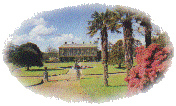
Cornish Gardens
Kernewek Lowarth
Web: www.greatgardensofcornwall.co.uk
Web: www.cornwallgardenstrust.org.uk
Web: www.cornwallgardensociety.org.uk
Web: www.ngs.org.uk

 |
Cornish GardensKernewek LowarthWeb: www.greatgardensofcornwall.co.uk Web: www.cornwallgardenstrust.org.uk Web: www.cornwallgardensociety.org.uk Web: www.ngs.org.uk |
 |
Flowery places
All gardens, to some degree, owe their character to accidents of climate, geography and soil conditions: yet in Cornwall fate has equally played a part, creating an Eden for the plantsman.
Cornwall has a head start, in that it comes under the benign influence of the gulf stream. Extremes of temperature are relatively unknown and the soil acidity has encouraged a high degree of hybridisation with camellia and magnolia, azalea and rhododendron.
Cornwall's southern coast is like a giant hothouse that needs no glass. Forests of camellia's and rhododendrons wave at passing ships. The warming balm of the gulf stream, the early springs and long, lingering summers have created a sub-tropical enclave which, in the 19th century, encouraged a number of landowners to sponsor exotic plant-hunting expeditions throughout the then Empire.
The specimens they brought back were incorporated in formal gardens of astonishing scale and ambition. Despite the harsh extremes of salt spray, gales, and changes of ownership, most have survived - and each has a fascinating story to tell.
The Eden Project is a dramatic global garden the size of thirty football pitches nestling like a lost world in an old china clay pit near St. Austell and consists of several domes kept at different temperatures suiting many types of tropical plants.
Enjoy the award winning gardens of Heligan, near Mevagissey, lost for 75 years under a mountain of ivy, bramble and fallen timber and now the largest garden restoration in Europe, containing rockeries, summer-houses, a crystal grotto and rainforest-like valley called "The Jungle". The famous walled gardens are being restored to become the only working 19th century kitchen gardens in Britain with peach houses, vineries, a melon house and pineapple pit as well as more familiar fruit and vegetables of the era.
Nearby, magnificent Caerhays Castle is the home of the Williams family and the Williams Camellia's. This world-famous collection, and the rhododendrons, magnolias and azaleas that appear with them, provide a massive and exotic barrage of colour in spring, when the castle and lovely, seaside grounds are open.
Tregrehan, near Par, home of the Carlyon family since 1565, plays host to a fine collection of mature trees including varieties from North America and Japan as well as rhododendrons and a range of Carlyon Hybrid Camellia's.
Others, hardly more distant, demand your attention. There is the house and 450-acre park of Lanhydrock, first built and landscaped in the 17th century but almost completely devastated by fire in 1881, and now largely restored and replanted. And Trewithen, the Michelin award-winning estate near St. Austell, which has been owned by the same family since 1715, and which contains in its 30 acres of park perhaps the finest plant collection in the country.
Trelissick Gardens at Feock near Truro, are National Trust owned and are just a short ferry ride on the King Harry Ferry from the Roseland Peninsula.
Further south are the luscious gardens located near the Helford Estuary such as Carwinion, Glendurgan and Trebah to name a few.
| A - E | F - L | M - R | S - Z |
The National Trust in Cornwall Ancient Sites in Cornwall Cornwall's Garden Centres